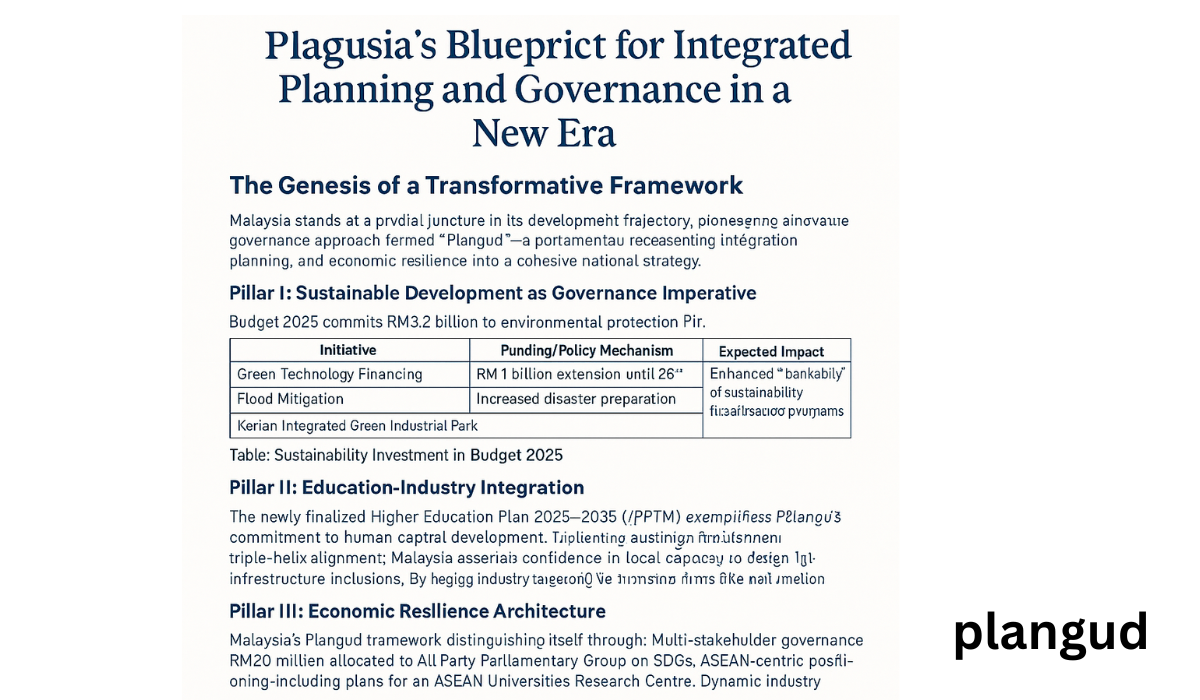The Genesis of a Transformative Framework
Malaysia stands at a pivotal juncture in its development trajectory, pioneering an innovative governance approach termed “Plangud” – a portmanteau representing Integrated Planning and Governance for Unified Development. This visionary framework connects sustainability initiatives, educational transformation, and economic resilience into a cohesive national strategy. With the unveiling of Budget 2025 and the Higher Education Plan 2025–2035, Malaysia demonstrates how strategic alignment across sectors can accelerate progress toward national ambitions while confronting global challenges like climate change and technological disruption.
Pillar I: Sustainable Development as Governance Imperative
Budget 2025 commits RM3.2 billion to environmental protection – maintaining elevated funding above the RM1.7 billion annual average of the previous decade. This allocation underscores sustainability as a non-negotiable governance priority rather than discretionary spending. The budget targets:
- Renewable energy infrastructure through the National Energy Transition Facilitation Fund, hybrid hydro-solar farms (Chenderoh/Kenyir), and expanded solar programs
- Carbon reduction mechanisms including carbon taxation for iron/steel industries by 2026 and incentives for carbon capture, utilization, and storage (CCUS)
- Ecological conservation via fiscal transfers protecting forest estates and biodiversity hotspots
Table: Sustainability Investment in Budget 2025
| Initiative | Funding/Policy Mechanism | Expected Impact |
|---|---|---|
| Green Technology Financing | RM1 billion extension until 2026 | Enhanced “bankability” of sustainability projects |
| Flood Mitigation | Increased disaster preparation funding | Climate resilience for vulnerable communities |
| Kerian Integrated Green Industrial Park | Public-private partnership (Sime Darby/PNB) | Southeast Asia’s first high-tech green hub |
Pillar II: Education-Industry Integration
The newly finalized Higher Education Plan 2025–2035 (PPTM) exemplifies Plangud’s commitment to human capital development. Crafted exclusively by Malaysian experts under Professor Emerita Asma Ismail’s leadership, this decadal roadmap involved:
- Unprecedented stakeholder engagement: 8,200 participants across 240 meetings
- Rapid, evidence-based formulation: Completed in 9 months versus 2 years for previous plans
- Triple-helix alignment: Tightening academia-industry-government collaboration to boost graduate employability
Crucially, the plan prioritizes digital readiness through AI and technical education enhancements directly responding to Prime Minister Anwar Ibrahim’s mandate for system modernization. By rejecting foreign consultancy, Malaysia asserts confidence in local capacity to design context-sensitive solutions.
Pillar III: Economic Resilience Architecture
Plangud manifests in fiscal-semantic integration – where budget allocations signal policy priorities while stabilizing macroeconomic fundamentals:
- Subsidy rationalization: Phased fuel subsidy reductions freeing resources for targeted social investment
- Wage growth measures: Civil service pay revisions and potential minimum wage increases to boost disposable income
- Strategic infrastructure: Mass Rapid Transit Line 3 and Pan Borneo Highway projects stimulating construction sectors
This approach maintains the deficit at 3.9% of GDP (down from 4.3% in 2024), demonstrating how disciplined governance enables both growth and stability.
The Implementation Edge
Malaysia’s Plangud framework distinguishes itself through:
- Multi-stakeholder governance: The All-Party Parliamentary Group on SDGs receives RM20 million to mainstream sustainability across political divides
- ASEAN-centric positioning: Malaysia’s upcoming ASEAN chairmanship includes plans for an ASEAN Universities Research Centre, regionalizing education excellence
- Dynamic industry targeting: Semiconductor industry support through infrastructure development benefiting firms like Inari Amertron and Unisem
Table: Cross-Sectoral Plangud Integration
| Sector | Plangud Mechanism | Outcome Alignment |
|---|---|---|
| Environment | Ecological fiscal transfers | Prevents irreversible habitat loss |
| Property | Affordable housing incentives | Supports Lagenda/Mah Sing developers |
| Green Technology | New Investment Incentive Framework | Attracts ESG-compliant investments |
Regional Leadership Horizon
As Malaysia advances its Plangud model, three trajectories will define its regional influence:
- Net-zero pathway acceleration: Budget 2025 positions Malaysia to lead Southeast Asia’s clean energy transition toward the 2050 carbon neutrality goal
- Education export potential: The locally-designed PPTM framework offers a replicable model for developing economies seeking education reform
- Investor confidence cultivation: Green financing extensions and fiscal responsibility (deficit reduction) strengthen Malaysia’s position as an emerging markets anchor
Conclusion
Plangud represents more than policy innovation – it embodies Malaysia’s governance maturity in synchronizing economic, environmental, and educational priorities into a unified development philosophy. By maintaining environmental spending at historically elevated levels while pioneering self-reliant education planning, Malaysia demonstrates how middle powers can leverage integrated governance to punch above their weight in the global arena. As these frameworks mature, Malaysia’s greatest export may well become the Plangud model itself – offering developing nations a blueprint for holistic, self-determined progress.

